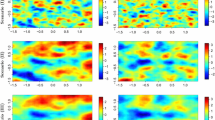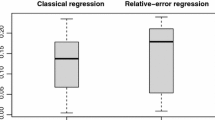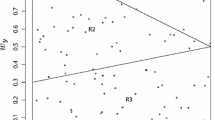Abstract
Matrix-valued radially symmetric covariance functions (also called radial basis functions in the numerical analysis literature) are crucial for the analysis, inference and prediction of Gaussian vector-valued random fields. This paper provides different methodologies for the construction of matrix-valued mappings that are positive definite and compactly supported over the sphere of a d-dimensional space, of a given radius. In particular, we offer a representation based on scaled mixtures of Askey functions; we also suggest a method of construction based on B-splines. Finally, we show that the very appealing convolution arguments are indeed effective when working in one dimension, prohibitive in two and feasible, but substantially useless, when working in three dimensions. We exhibit the statistical performance of the proposed models through simulation study and then discuss the computational gains that come from our constructions when the parameters are estimated via maximum likelihood. We finally apply our constructions to a North American Pacific Northwest temperatures dataset.



Similar content being viewed by others
References
Abramowitz M, Stegun IA (1964) Handbook of mathematical functions, applied mathematical series 55. National Bureau of Standards, Washington. (reprinted 1968 by Dover Publications, New York.)
Apanasovich TV, Genton MG (2010) Cross-covariance functions for multivariate random fields based on latent dimensions. Biometrika 97:15–30
Askey R (1973) Radial characteristic functions, technical report no. 1262. Mathematical Research Center, University of Wisconsin-Madison, Madison (1973)
Banerjee S, Gelfand AE (2003) On smoothness properties of spatial processes. J Multivar Anal 84:85–100
Banerjee S, Carlin BP, Gelfand AE (2004) Hierarchical modeling and analysis for spatial data. Chapman & Hall, Boca Raton
Beatson RK, zu Castell W, Schroedl S (2009) Kernel based methods for vector-valued data with correlated components. Preprint. Helmholtz-Zentrum, München
Benbourhim M, Bouhamidi A (2005) Approximation of vector fields by thin plate splines with tension. J Approx Theor 136:198–229
Berrocal VJ, Raftery AE, Gneiting T (2008) Probabilistic quantitative precipitation field forecasting using a two-stage spatial model. Ann Appl Stat 2:1170–1193
de Boor C (1978) A practical guide to splines. Springer, New York
Buhmann M (2001) A new class of radial basis functions with compact support. Math Comput 70:307–318
Chilés J-P, Delfiner P (1999) Geostatistics: modeling spatial uncertainty. Wiley, New York
Christakos G (2000) Modern spatiotemporal geostatistics. Oxford University Press, New York
Christakos G, Hristopoulos D (1998) Spatiotemporal environmental health modeling: a tractatus stochasticus. Kluwer, Boston
Cramér H (1940) On the theory of stationary random functions. Ann Math 41:215–230
Cressie NAC (1993) Statistics for spatial data, revised edition. Wiley, New York
Du J, Zhang H, Mandrekar V (2009) Infill asymptotic properties of tapered maximum likelihood estimators. Ann Stat Bull Metrop Insur Co 37:3330–3361
Eckel AF, Mass CF (2005) Aspects of effective mesoscale short-range ensemble forecasting. Weather Forecast 20:328–350
Furrer R, Genton M, Nychka D (2006) Covariance tapering for interpolation of large spatial datasets. J Comput Graph Stat 15:502–523
Gaspari G, Cohn SE (1999) Construction of correlation functions in two and three dimensions. Q J R Meteor Soc 125:723–757
Gneiting T (2001) Criteria of pólya type for radial positive definite functions. Proc Am Math Soc 129:2309–2318
Gneiting T (2002a) Nonseparable, stationary covariance functions for space–time data. J Am Stat Assoc 97:590–600
Gneiting T (2002b) Compactly supported correlation functions. J Multivar Anal 83:493–508
Gneiting T, Kleiber W, Schlather M (2010) Matérn cross-covariance functions for multivariate random fields. J Am Stat Assoc 105:1167–1177
Goovaerts P (1997) Geostatistics for natural resources evaluation. Oxford University Press, New York
Goulard M, Voltz M (1992) Linear coregionalization model: tools for estimation and choice of cross-variogram matrix. Math Geol 24:269–282
Horn R.A., Johnson C.H. (1986) Matrix Analysis. Cambridge: Cambridge University Press
Hristopoulos D, Porcu E (2012) Spartan vector-valued random fields. Submitted
Kaufman C, Schervish M, Nychka D (2008) Covariance tapering for likelihood-based estimation in large spatial datasets. J Am Stat Assoc 103:1545–1555
Li B, Genton MG, Sherman M (2008) Testing the covariance structure of multivariate random fields. Biometrika 95:813–829
Majumdar A, Gelfand AE (2007) Multivariate spatial modeling for geostatistical data using convolved covariance functions. Math Geol 39:225–245
Matérn B (1986) Spatial variation, 2nd edn. Springer, Berlin
Matheron G (1962) Traité de Géostatistique appliquée, tome 1 (1962), tome 2 (1963). Editions Technip, Paris
Misiewicz J (1989) Positive definite functions on \(l_{\infty}. \) Statist Probab Lett 8:255–260
Narcowich FJ, Ward JD, Wright GB (2007) Divergence-free RBFs on surfaces. J Fourier Anal Appl 13:643–663
Powell MJD (1981) Approximation theory and methods. Cambridge University Press, Cambridge
Porcu E, Gregori P, Mateu J (2006) Nonseparable stationary anisotropic space–time covariance functions. Stoch Environ Res Risk Assess 21:113–122
Porcu E, Zastavnyi V (2011) Characterization theorems for some classes of covariance functions associated to vector valued random fields. J Multiv Anal 102(9):1293–1301
Schaback R (2011) The missing Wendland functions. Adv Comput Math 34(1):67–81
Schoenberg IJ (1938) Metric spaces and completely monotone functions. Ann Math Ann 39:811–841
Schlather M (2010) Some covariance models based on normal scale mixtures. Bernoulli 16:780–797
Schmidt AM, Gelfand AE (2003) A Bayesian coregionalization approach for multivariate pollutant data. J Geophys Res Atmos 108: D24 (article no. 8783)
Stein ML (1999) Interpolation of spatial data. Springer, New York
Ver Hoef JM, Barry RP (1998) Constructing and fitting models for cokriging and multivariable spatial prediction. J Stat Plan Inf 69:275–294
Wackernagel H (2003) Multivariate geostatistics, 3rd edn. Springer, Berlin
Wendland H (1994) Ein Beitrag zur Interpolation mit radialen Basisfunktionen. Diplomarbeit, Göttingen
Wendland H (1995) Piecewise polynomial, positive definite and compactly supported radial functions of minimal degree. Adv Comput Math 4:389–396
Wendland H (2005) Scattered data approximation. Cambridge monographs on applied and computational mathematics. Cambridge University Press, Cambridge
Whittaker ET, Watson GN (1927) A course of modern analysis, 4th edn. Cambridge University Press, Cambridge
Williamson RE (1956) Multiply monotone functions and their Laplace transforms. Duke Math J 23:189–207
Zastavnyi VP (2004) On properties of the Buhmann function. Ukrainian Math J 58:1184–1208
Zastavnyi VP (2008) Problems related to positive definite functions. In: Mateu J, Porcu E (eds) Positive definite functions: from Schoenberg to space–time challenges. Editorial Universitat Jaume I, Barcelona, p 63–114
Acknowledgements
D.J. Daley’s work was done partly as an Honorary Professorial Associate in the School of Mathematics and Statistics at the University of Melbourne, and partly while visiting the University of Göttingen. Support both in kind and towards living away from home is gratefully acknowledged. The authors thank Professor Victor Léiva for useful discussions during the preparation of this manuscript.
Author information
Authors and Affiliations
Corresponding author
Appendix
Appendix
Some proofs
Proof of Theorem 1.
Direct inspection shows that
for \(\psi_{\nu-1,0,\beta}(\cdot)\in\Upphi(\mathbb{R}^d),\; \nu\ge\frac{1}{2} d+2\) and \(\beta\mapsto g(\beta;\mu) := \beta^\nu(1-\beta)_+^\mu,\quad \mu\ge 0. \) This is evidently of the form in Eq. (8), being a special case of Theorem A, so that we only need to show that the matrix-valued mapping
belongs to the class \(\Upphi^m\) for all \(0\le \beta \le 1\) and \({\mu} \in \mathbb{R}_+^{{\text {m}}({\text {m}}+1)/2}. \) To do this we appeal to the stronger statement of diagonal dominance and nonnegativity of the elements on the diagonal, which follows from noting that
Because positive definiteness is preserved under scale mixtures and under Schur products with the positive-definite matrix \(\mathbf{c}\) of coefficients \(c_{ij}\) used in Eq. (9), the proof is complete.
Proof of Proposition 3.
The proof is again constructive. The structure in Eq. (11) is obtained through the Schur product of the matrix based on (9), namely
with the matrix \(\mathbf{C}(\cdot)\) defined in Eq. (9) for m = 2, so that we only need to verify that the matrix above is positive definite; this is indeed the case when the condition in Eq. (12) holds. The condition \(\mu_{12} \le {\textstyle\frac{1}{2}}(\mu_{11}+\mu_{22})\) comes from the matrix \(\mathbf{C} (\cdot)\) in Eq. (11) for the case m = 2 via a determinantal inequality.
Proof of Proposition 5.
We detail some algebra involving the convolution \((\psi_{{\nu}}* \psi_{{\mu}})(t),\quad t\in{\mathbb{R}}, \) of the basic Askey functions \(\psi_{{\nu}}(t):= (1 - |t|)_+^\nu\) under the restriction \(\nu, \mu \in \mathbb N, \) namely
As written in (16) the functions are defined on the interval [−1, 1] in \({\mathbb{R}}^1; \) the essential features are that they are nonnegative, are positive definite for \(\nu,\mu\) greater or equal than two, and have compact support. The convolution at (16) also has compact support, albeit on [−2, 2].
We evaluate (16) for positive integers \(\nu\) and \(\mu. \) Observe that the function on the left-hand side is symmetric about the origin so that it is a function of \(|t|. \) Indeed, inspection of the right-hand side shows that the first factor of the integrand is exactly \((1-t+u)_+^\nu \)for \(1<t<2, \)and in this range it is nonzero only for \(t-1<u<1. \) So for such t (and, indeed, for \(|t| = t\)) the integral equals
For \(0<t<1, \) the set of values of u making positive contributions to the convolution expands to \(-(1-t) < u < 1, \) while
Writing the convolution integral at (16) for this range of u as \(\int_{-(1-t)}^1 \cdots = \big(\int_{-(1-t)}^0 + \int_0^t + \int_t^1\big)\cdots, \) we evaluate each of these contributions as below:
Putting together (18)–(20) gives for this integration, when \(0<t<1, \)
Finally then, \((\psi_{{\nu}}*\psi_{{\mu}})(t)\) is zero except when \(|t|<2\) where it is as given at (13) and (14) of Proposition 5 for \(\nu_i=\nu, \nu_j=\mu\) and \(|t|=|x|. \)
Derivation of convolution formulae in \(\mathbb{R}^3. \)
The argument sketched below follows the lines of Theorem 3.c.1 in Gaspari and Cohn (1999), and shows that the convolution \((C_i *C_j)(z)\) of two radial functions compactly supported in the unit ball of \(\mathbb{R}^3, \) when their centres are distance z apart, is expressible
Appealing to the formula at (21), we calculate the convolution \((\psi_{{\nu}}* \psi_{{\mu}})(z)\) of two Wendland–Gneiting functions as
The inner integrand at (22) equals
where the upper limit replaces the truncation in the integrand. For the case \(r>z\) this equals
after integration by parts, and depending on \(r+z>\) or \(\le 1, \) this equals
The case \(z>r\) equals
Here the case that \(r+z>1\) can be given as the single expression
the case \(r+z\le 1\) also gives a single expression in terms of \(|z-r|. \)
To evaluate the expression at (22) write \(\int_0^1 (\cdots) \mathrm{d} r = \Big(\int_0^{1-z} + \int_{1-z}^1 \Big) (\cdots) \mathrm{d} r. \) This gives two integrals
and
To evaluate J 1 we must distinguish the two cases according as \(1-z>\)or\(< z, \) i.e. according as \(z<\frac{1}{2}\) or \(z>\frac{1}{2}. \) For the simpler case \(z<\frac{1}{2}, \)
while for the case \(z>\frac{1}{2}\) we use \(\int_{1-z}^1 = \int_{1-z}^z + \int_z^1\) and find
The rest of the formula is then deduced through simple, albeit tedious, algebra. Table 2 shows some special cases of the formulae above, obtained for \(\mu\) and \(\nu\) positive integers.
Rights and permissions
About this article
Cite this article
Porcu, E., Daley, D.J., Buhmann, M. et al. Radial basis functions with compact support for multivariate geostatistics. Stoch Environ Res Risk Assess 27, 909–922 (2013). https://doi.org/10.1007/s00477-012-0656-z
Published:
Issue Date:
DOI: https://doi.org/10.1007/s00477-012-0656-z




